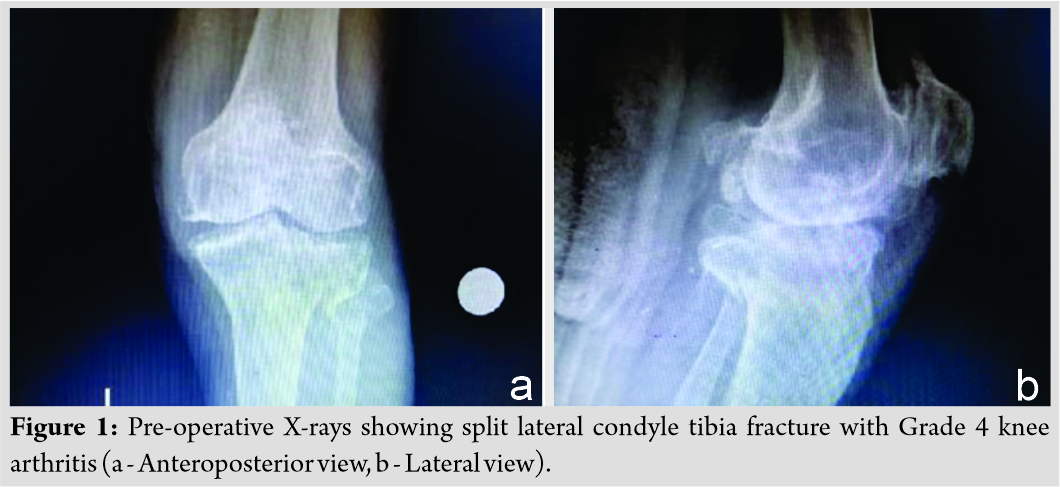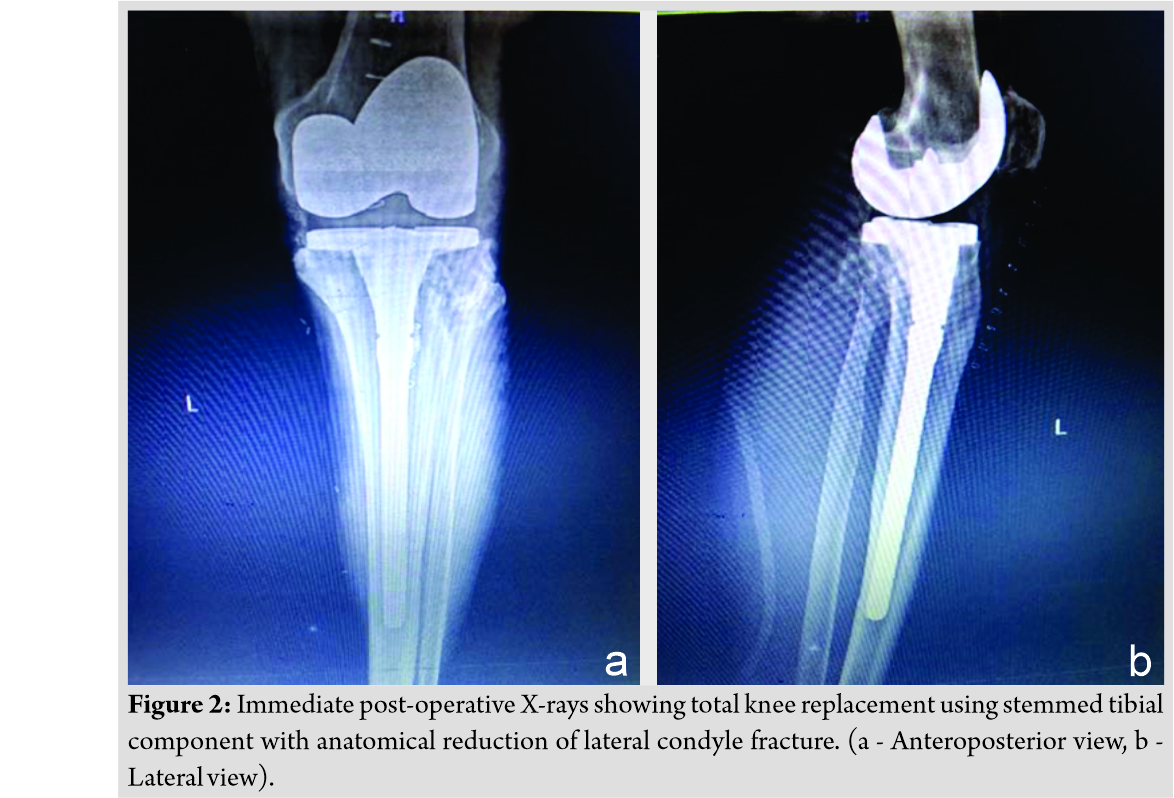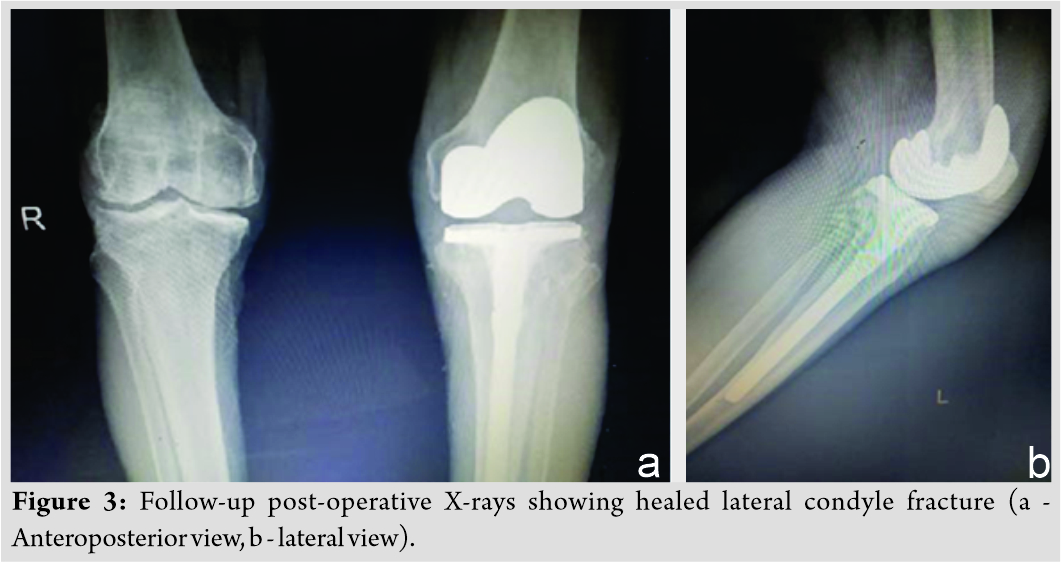[box type=”bio”] Learning Point of the Article: [/box]
Primary total knee replacement is a viable alternative to internal fixation in elderly patients with lateral tibial condyle fracture with preexisting arthritis.
Case Report | Volume 10 | Issue 5 | JOCR August 2020 | Page 1-4 | Neetin P Mahajan, Ajay S Chandanwale, Prasanna Kumar .G S, Abhishek Harsoor, Lalkar Gadod, Amey Sadar. DOI: 10.13107/jocr.2020.v10.i05.1810
Authors: Neetin P Mahajan[1], Ajay S Chandanwale[2], Prasanna Kumar .G S[1], Abhishek Harsoor[1], Lalkar Gadod[1], Amey Sadar[1]
[1]Department of Orthopaedics, Grant Government Medical College and Sir JJ Group of Hospitals, Mumbai, Maharashtra, India,
[2]Directorate of Medical Education and Research, Mumbai, Maharashtra, India.
Address of Correspondence:
Dr. Prasanna Kumar. G S,
Department of Orthopaedics, Grant Government Medical College and Sir JJ Group of Hospitals, Mumbai, Maharashtra, India.
E-mail: prasannakumargs5@gmail.com
Abstract
Introduction: Tibial plateau fractures are not uncommon. These fractures occur in bimodal age distribution consisting of 8% of all geriatric fractures. They usually occur as a result of low-energy trauma in the elderly. The management options include closed/open reduction and internal fixation (ORIF) using screws and plates. The osteosynthetic treatment options cause malreduction, non-union, implant failure in elderly patients due to osteoporosis and this may lead to post-traumatic arthritis, requiring total knee replacement (TKR) as a secondary procedure later.
Case Report: A 76-year-old male patient presented with pain and swelling in the left knee with a history of trauma to the left knee. X-ray of the left knee showed the split fracture of the left lateral tibial condyle with severe Grade 4 osteoarthritis. On examination, tenderness was present over the lateral tibial condyle. We managed with cemented primary TKR using stemmed tibial component. Postoperatively, the patient is having good knee range of motion and having no difficulty in walking and weight-bearing. Functional outcome is good as per Oxford knee score.
Conclusion: Primary TKR is a viable alternative treatment option compared to ORIF in elderly patients with preexisting osteoarthritis with tibial condyle fractures. It helps in early mobilization, weight-bearing and avoids secondary surgical procedures.
Key words: Delayed union, Lateral tibial condyle fracture, Osteoarthritis, Total knee replacement.
Introduction
Tibial plateau fractures are the common injuries around the knee which occurs as a result of high-energy trauma in young adults and low-energy injury in old and osteoporotic individuals. These fractures constitute about 8% of all fractures above the age of 65 years [1]. Intra-articular proximal tibial fractures are difficult to treat in elderly patients because of high incidence of soft-tissue injury, comminution, and osteoporosis [2]. The treatment option available for these patients includes conservative management using knee brace/above knee slab in case of undisplaced or minimally displaced fractures, but this may lead to knee stiffness due to long-term immobilization and the other modalities of management include percutaneous CC screw fixation or open reduction and internal fixation (ORIF) with plates. Operative management helps in early mobilization compared to conservative management, but the weight-bearing will be delayed. However, malreduction, implant failure, and knee stiffness are the problems associated with osteosynthesis because of poor bone stock and already preexisting knee arthritis in elderly patients, may require secondary operative procedures for the same. Another available option for the management of tibial plateau fractures in elderly patients with associated osteoarthritis is primary total knee replacement (TKR) using hinged knee prosthesis for fractures associated with ligament laxity or long tibial stem implant which helps in early mobilization and weight-bearing [3]. Primary TKR for the treatment of proximal tibial fracture in the elderly is a challenging operation due to distorted anatomy and poor bone stock which poses problems in taking tibial cut, while cementing and implantation. With the improved implant designs, nowadays, it is possible to perform this type of surgeries with minimal complications.
Case Report
A 76-year-old male patient came to our hospital with complaints of pain, swelling, and difficulty in flexing and weight-bearing in the left knee. The patient had a history of fall from bike 15 days back and took treatment at the local hospital for the same in the form of above knee slab and was referred to our hospital. There was no history of any head, chest, and abdominal injury and the patient was not a known case of hypertension and diabetes. The patient had a history of coronary artery bypass graft surgery 6 years back and is on tablet Ecosprin since then. On local examination, tenderness was present over the lateral tibial condyle, skin condition was good, and range of motion was restricted. X-ray of the left knee was taken, which was suggestive of the left tibia lateral condyle split fracture (Schatzker type 1) with severe osteoarthritis of the left knee (Fig. 1a and b). The patient was managed initially with above knee slab and limb elevation. As the patient was having osteoarthritis with fracture, we planned for primary TKR with stemmed tibial component. Surgery was postponed for 15 days because of patient medical fitness issues.
After getting the fitness for surgery (40 days after the trauma), the patient was operated in supine position through medial parapatellar approach using tourniquet. After the femur preparation, tibial preparation was started with removal of fibrous tissue at the fracture site, anatomical reduction of fracture, and maintaining the reduction with reduction forceps till the completion of the tibial preparation to prevent the displacement of fracture fragment. Cemented TKR was done using Zimmer implant of femoral component size E, tibial component of size 4 with stem extension of 12 mm diameter × 155 mm length and articular surface height of 10 mm (Fig. 2a and b). As the fracture was properly reduced to anatomical position and there was only fracture split, no depression, the augmentation was not required. Wound was closed in layers and the patient was given long knee brace postoperatively. Partial weight-bearing and knee range of motion were started after 3 days and full weight-bearing was started after 3 weeks. Eight months post-operative X-rays (Fig. 3a and b) showed healing of lateral condyle fracture and without any loosening of implants. The patient is having good knee range of movements and no pain on weight-bearing at present (Fig. 4a and b).
At present 1.2 years follow-up, the patient is comfortable with no pain and difficulty in walking. Functional outcome is good as per Oxford knee score. Shorter follow-up period is the limitation of this case report.
Discussion
Fractures around the knee in elderly osteoporotic patients are challenging. ORIF frequently results in loss of reduction, which can result in post-traumatic arthritis and requires the need for TKR ultimately. Late TKR after failed fixation can be technically difficult, with moderate functional outcomes and high complication rates. TKR, however as the primary method of treatment, appears to have superior functional outcomes, survival, and lower complication rates [4]. TKR performed as secondary procedures following tibial plateau fracture has revision rates ranging from 8% to 20%, complication rates from 24% to 48%, and offers good outcomes in only about three-quarters of patients [5, 6]. According to Abdelbadie et al. [7], primary TKR using stemmed tibial component is significantly more efficient than ORIF by locking plate in regaining better range of motion and knee society score and function scores when treating elderly patients with a complex fracture of the tibial plateau. It allows immediate postoperative weight-bearing with fewer complication rate, which is similar to findings observed in our patient. The main issue is resumption of full weight-bearing, which should be immediate whenever possible and the principles of post-operative management of the elderly include replacing the blood loss, preventing decubitus complications, managing anticoagulation, and treating the comorbidities [8]. The same protocol was followed in our case. Pre-operative planning is the major step before the surgery, which helps in getting good functional outcome. Implant type and level of constraint required should be assessed based on pre-operative X-rays. Use of stemmed cemented components in the elderly helps in early weight-bearing. Primary surgery should be done within 3 weeks of injury to get better functional outcome [9], but in our case, this was delayed because of patient comorbidity. Tibial plateau fractures are well managed with stemmed prosthesis to bypass the fracture site. Diaphyseal fixation of the stemmed implant prevents forces occurring at the component level and provides stability [10]. According to Huang et al. [11] and Boureau et al. [12], primary TKR is an effective method of treatment in elderly patients with tibia plateau fractures.
Conclusion
Primary TKR is a viable alternative treatment option compared to ORIF in elderly patients with preexisting osteoarthritis with tibial condyle fractures. It helps in early mobilization, weight-bearing and avoids secondary surgical procedures.
Clinical Message
Primary TKR in patients with lateral tibial condyle fracture with preexisting knee arthritis helps in early mobilization, weight-bearing and avoids secondary procedures.
References
1. Hsu CJ, Chang WN, Wong CY. Surgical treatment of tibial plateau fracture in elderly patients. Arch Orthop Trauma Surg 2001;121:67-70.
2. Chin TY, Bardana D, Bailey M, Williamson OD, Miller R, Edwards ER, et al. Functional outcome of tibial plateau fractures treated with the fine-wire fixator. Injury 2005;36:1467-75.
3. Vermeire J, Scheerlinck T. Early primary total knee replacement for complex proximal tibia fractures in elderly and osteoarthritic patients. Acta Orthop Belg 2010;76:785-93.
4. Bohm ER, Tufescu TV, Marsh JP. The operative management of osteoporotic fractures of the knee: To fix or replace? J Bone Joint Surg Br 2012;94:1160-9.
5. Saleh KJ, Sherman P, Katkin P, Windsor R, Haas S, Laskin R, et al. Total knee arthroplasty after open reduction and internal fixation of fractures of the tibial plateau: A minimum five-year follow-up study. J Bone Joint Surg Am 2001;83:1144-8.
6. Weiss NG, Parvizi J, Trousdale RT, Bryce RD, Lewallen DG. Total knee arthroplasty in patients with a prior fracture of the tibial plateau. J Bone Joint Surg Am 2003;85:218-21.
7. Abdelbadie A, El-Hennawy A, Sallam A. Primary total knee arthroplasty: A viable surgical option for complex tibial plateau fractures in elderly. J Knee Surg 2019;33:496-503.
8. Parratte S, Ollivier M, Argenson JN. Primary total knee arthroplasty for acute fracture around the knee. Orthop Traumatol Surg Res 2018;104:S71-80.
9. Softness KA, Murray RS, Evans BG. Total knee arthroplasty and fractures of the tibial plateau. World J Orthop 2017;8:107-14.
10. Agarwala S, Bajwa S, Vijayvargiya M. Intra-operative fractures in primary total knee arthroplasty. J Clin Orthop Trauma 2019;10:571-5.
11. Huang JF, Shen JJ, Chen JJ, Tong PJ. Primary total knee arthroplasty for elderly complex tibial plateau fractures. Acta Orthop Traumatol Turc 2016;50:702-5.
12. Boureau F, Benad K, Putman S, Dereudre G, Kern G, Chantelot C. Does primary total knee arthroplasty for acute knee joint fracture maintain autonomy in the elderly? A retrospective study of 21 Cases. Orthop Traumatol Surg Res 2015;101:947-51.
 |
 |
 |
 |
 |
| Dr. Neetin P Mahajan | Dr. Ajay S Chandanwale | Dr. Prasanna Kumar .G S | Dr. Abhishek Harsoor | Dr. Lalkar Gadod |
| How to Cite This Article: Mahajan NP, Chandanwale AS, Kumar GSP, Harsoor A, Gadod L, SadarA. Primary Total Knee Replacement in a Case of Lateral Tibial Condyle Delayed Union with Severe Grade 4 Osteoarthritis Knee – A Case Report. Journal of Orthopaedic Case Reports 2020 August;10(5): 1-4 |
[Full Text HTML] [Full Text PDF] [XML]
[rate_this_page]
Dear Reader, We are very excited about New Features in JOCR. Please do let us know what you think by Clicking on the Sliding “Feedback Form” button on the <<< left of the page or sending a mail to us at editor.jocr@gmail.com







